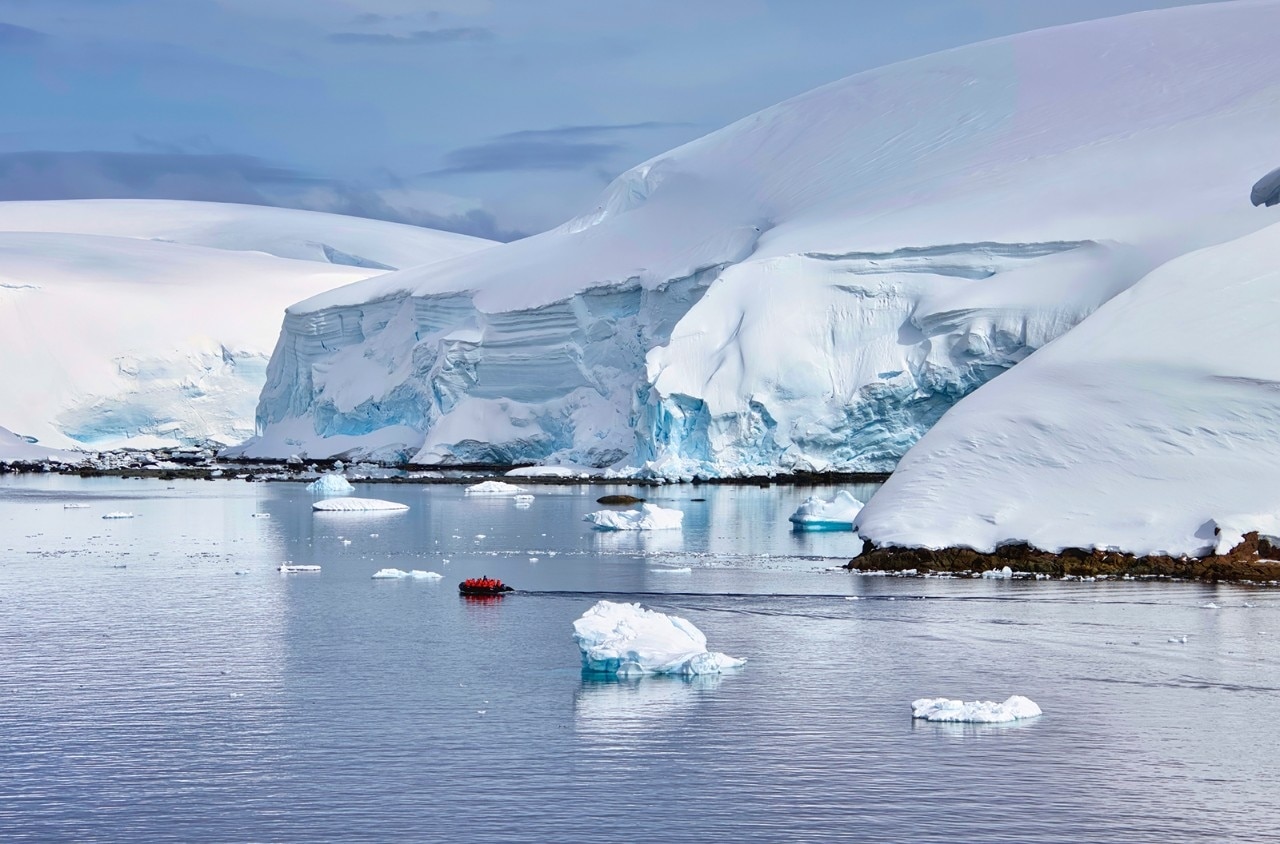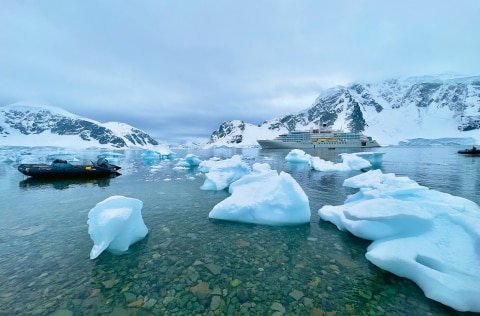The Once-in-a-Lifetime Adventure to Add to Your Bucket List

Antarctica promises a once-in-a-lifetime adventure but can it live up to the hype?
I’m in a kayak in the middle of the Antarctic Peninsula. It’s snowing but the water is like glass, barely moving. Until it does. A pack of Gentoo penguins skip past, hurtling themselves into the air and diving back under. Then, as if it’s a competition, two humpback whales dial up the drama by breaching in front of me, a mere 50 metres away. I hold my breath as they submerge, only exhaling when they again rise in unison.

Antarctica brings with it lofty expectations of ice that shimmers blue, ’bergs that are bigger than buildings and thousands of penguins, seals and whales. A frosted wonderland that offers alien landscapes and a stillness that can only be found at the bottom of the earth. But in the weeks leading up to my journey, I have one nagging question. Can Antarctica measure up to the fantasy and be as amazing as everyone says?

“We go to the most remote parts of the world,” says Peter Bergman, the (perfectly named) expedition leader on Silversea’s Silver Endeavour, who is doing his fifth season in Antarctica. “Our operations are at the mercy of the weather, the conditions of the sea and the ice, and, of course, the wildlife.”
To experience the best of the Antarctic region, you’ll need to travel by ship. There are some charter boats that sail around but the larger cruise companies offer a seamless experience and expedition teams accustomed to the vagaries of the continent. Silversea has been sailing in the polar region for 15 years and since purchasing Crystal Cruise’s Endeavour in 2022 for a cool US$275 million, claims it now operates the most luxurious vessel in all of Antarctica.
Almost 200 people – many of them first-time cruisers – have joined this six-day adventure, which will snake around the Antarctic Peninsula, dubbed the “serpentine spine” for its curved shape. We’re on what’s called an Antarctica Bridge expedition – which Silversea has only been offering since 2022 – allowing time-poor travellers to bypass the famous Drake Passage and fly directly from Punta Arenas, in the very south of Chile, to King George Island by charter flight (and avoid four days at sea). But 24 hours before we are due to fly, there’s news. An unseasonal snow squall means the runway on the island is blanketed by 40 centimetres of snow and we won’t be taking off. Instead, we’ll follow in the footsteps of the explorers of old – from Shackleton to Scott and Amundsen to Mawson – and contend with the 1000-kilometre-wide Drake, which is notoriously treacherous.
Our captain, Ulf-Peter Hansen-Lindström, tells me later that he has steered the Silver Endeavour through 17-metre swells at its worst but we’re in luck. When we shuffle on board at Puerto Williams – the southernmost city in the world – entertainment host Jonathan Shade promises that it will be “more Drake Lake” than “Drake Shake”, with the swells only up to two metres. So we spend our first 24 hours on the ship attending lectures on glaciers and marine mammals, poking around the eight decks and warding off any bouts of nausea with seasickness medication and ginger chews.

As we sail towards the South Shetland Islands, we pass a multitude of icebergs, many of which have taken momentous journeys of their own, floating hundreds of kilometres from the Amundsen Sea in Antarctica’s west. These tabular icebergs, which have broken off ice shelves, are mesmerising in their size, shapes and shades. The first one I see resembles the boot of a flat-footed giant. Some look like oversized, three-tiered cakes. What lies beneath? Is it really just “the tip of the iceberg”? Yes, says geologist Julien Cornet. “You see 10 per cent of them and 90 per cent of them you don’t.”
Sometimes they glow white, like the brightest of beacons. Other times, they are every shade of blue you can imagine, from pale fairy floss to what I dub “smurf”. Hedda Andersen, another geologist, tells us that it’s the older, dense ice that has the colour. “The more compact the ice, the less air it contains.”

Before every expedition, Bergman briefs us on what to expect – and lays down the law. “We want to keep Antarctica pristine and we don’t want to have a negative impact on the environment,” he says, explaining that Silversea is a member of the International Association of Antarctic Tour Operators (IAATO) and is committed to safe and environmentally responsible travel in the region. Only 100 people are allowed onshore at a time, shuttled over in Zodiacs. “If you have dirty boots, we’ll ask you to go back and clean them. It’s our responsibility to make sure we are as bio-secure as possible.”
Boots, poles and tripods are decontaminated and we’re told not to touch a thing or put our backpacks on the ground. “And you must keep – and maintain – a distance of five metres from the wildlife,” says Bergman. “If there’s a lot of wildlife nesting in one spot, we won’t go there.”

As soon as we land on Deception Island – an active volcano that is a former whaling station and our first stop – I see a hefty Weddell seal taking a much-deserved nap on the shore. And then my first penguins in the wild. These ones are Gentoos, which number 600,000 in Antarctica, and I watch one couple flapping about together. “There’s a half arsed courtship going on here,” quips Nicholas Bredenkamp, a marine biologist and ornithologist.
It’s mating season and over the next few days, I watch thousands of female penguins throw their heads back, thrust their tangerine beaks to the sky and make tuneless honking sounds dubbed the “ecstatic display call”.
Life here is more precious than ever before. The ice is melting. And the peninsula we’re visiting is changing faster than anywhere else in Antarctica. “Winter climate change is a big factor,” says Andersen. “It’s becoming a lot milder. It’s six degrees warmer in the winter now than in the 1950s… and with that comes the danger of the melting of the ice sheets in the west of Antarctica – and it’s expected to accelerate.”
Is tourism sustainable in the region? “As long as it can be done responsibly and sustainably, it’s still a viable thing to do,” says Andersen, who has a master’s degree in glaciology. Tourism “opens people’s eyes to Antarctica”, she adds. “It really creates ambassadors for the continent because when you take it all in, you truly understand what’s going on down here and how it’s affected by our actions.”
“If you block travel here completely,” says Tyler Stern, the lead kayak guide, “people won’t care about it and won’t know why they should protect it.”
As I hop on and off the ship, I wonder what the explorers of the past would make of the grandeur of Endeavour. There are four eateries on board, including a fine-dining French restaurant, Italian trattoria and casual grill, as well as a comprehensive library and an Observation Lounge bar on level nine that offers stupendous views (and a nice line in Pisco Sours). There’s also an outdoor jacuzzi, steam room, spa and pool. The suites are much larger than most expedition vessels, with every room having a balcony, lounge area and good-sized bathroom. All guests are assigned a personal butler, who is on-call 24/7. It’s a far cry from the makeshift huts and perilous conditions Scott and co faced on a daily basis.
But like them, I’m keenly aware of the privilege of visiting this place. My favourite moments are spent bobbing about in a kayak, seeing the fragile ecosystem from a different perspective. I love feeling the clunk of the paddle against the ice as I glide through the “brash” (fragments of floating ice), which makes the water look like a wintry jigsaw. I thrill to see the icebergs from every angle.
And I’m wowed by the brightness. It’s as though the icebergs have been backlit. They are so blinding when I’m kayaking past that it hurts my eyes to look at them. This ice, it actually glows.
On one of my final mornings, we hurtle across the water in Zodiacs. A fellow guest, Ben, points and shouts, “Whales!” A pod of orcas is approaching us. Then we see another pod in front of us. And another to our right. Bergman tells me later that they have never seen orcas from Zodiacs before. And here we are surrounded by scores of the black and-white mammals as they fly in and out of the water. This is the power of Antarctica. The fantasy is real.

Start planning now
SEE ALSO: These Adventurous Cruises Are Taking Science Seriously
Image credit: Dirk Bischoff


